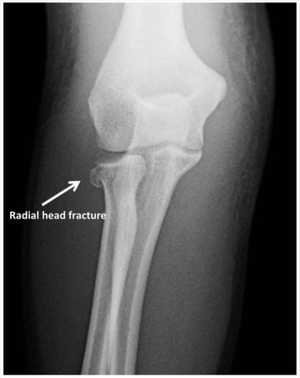We need you! Join our contributor community and become a WikEM editor through our open and transparent promotion process.
Radial head fracture (peds)
From WikEM
Contents
Background
- Radial neck fractures tend to be more common in the pediatric population than radial head fractures
- Majority are Salter II fractures
- Average age is approximately 10 yrs
Clinical Features
- Mechanism is typically FOOSH
- Tenderness over the elbow
- May include posterior interosseous nerve intrapment causing a finger drop
Differential Diagnosis
Elbow Diagnoses
Radiograph-Positive
Radiograph-Negative
- Lateral epicondylitis
- Medial epicondylitis
- Olecranon bursitis (nonseptic)
- Septic bursitis
- Biceps tendon rupture/dislocation
Pediatric
- Nursemaid's elbow
- Supracondylar fracture
- Lateral epicondyle fracture
- Medial epicondyle fracture
- Olecranon fracture
- Radial head fracture
- Salter-Harris fractures
Evaluation
- AP and lateral elbow xray
- Assess for anterior fat pad
- Knowledge of ossification centers of the elbow can be helpful
- Capitellum (1 yr.)
- Radius (3 yr.)
- Internal or medial epicondyle (5 yr.)
- Trochlea (7 yr.)
- Olecranon (9 yr.)
- External or lateral epicondyle (11 yr.)
Management
- Ortho consultation to guide treatment
- ORIF indicated when angulation >60 degrees or displacement >50%
Disposition
- Consult ortho
See Also
- Elbow diagnoses
- Radial head fracture (Adult)

